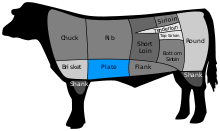
A beefsteak, often called just steak, is a flat cut of beef with parallel faces, usually cut perpendicular to the muscle fibers. In common restaurant service a single serving has a raw mass ranging from 120 to 600 grams. Beef steaks are usually grilled, pan-fried, or broiled. The more tender cuts from the loin and rib are cooked quickly, using dry heat, and served whole. Less tender cuts from the chuck or round are cooked with moist heat or are mechanically tenderized.

A fajita, in Tex-Mex cuisine, is any stripped grilled meat, optionally served with stripped peppers and onions usually served on a flour or corn tortilla. The term originally referred to skirt steak, the cut of beef first used in the dish. Popular alternatives to skirt steak include chicken and other cuts of beef, as well as vegetables instead of meat. In restaurants, the meat is usually cooked with onions and bell peppers. Popular condiments include shredded lettuce, sour cream, guacamole, salsa, pico de gallo, shredded cheese, refried beans, and diced tomatoes. "Tacos de arrachera" is applied to the northern Mexican variant of the dish.

Beef aging or ageing is a process of preparing beef for consumption by aging it, in order to break down the connective tissue within the meat.

A beef tenderloin, known as an eye fillet in Australasia, nautalund in Iceland, filet in France, filet mignon in Brazil, and fillet in the United Kingdom and South Africa, is cut from the loin of beef.

Filet mignon is a cut of meat taken from the smaller end of the tenderloin, or psoas major of a cow. In French, it mostly refers to cuts of pork tenderloin.

The rib eye or ribeye is a boneless rib steak from the rib section.

Flat iron steak (US), butlers' steak (UK), feather steak (UK) or oyster blade steak is a cut of steak cut with the grain from the chuck, or shoulder of the animal.

Flank steak is a cut of beef steak taken from the abdominal muscles of the cow, located just behind the plate and in front of the rear quarter. It is a long, flat cut with a significant grain, and is known for its bold flavor and chewiness.

Skirt steak is the US name for a cut of beef steak from the plate. It is long, flat, and prized for its flavor rather than tenderness. It is distinct from hanger steak (US), also called skirt (UK) or onglet, a generally similar adjacent cut also from the plate.

London broil is a beef dish made by grilling marinated beef, then cutting it across the grain into thin strips. While the inclusion of "London" in the name may suggest British origins, "broil" is not a common term in UK English, and indeed the dish is American, not British.

Pork ribs are a cut of pork popular in Western and Asian cuisines. The ribcage of a domestic pig, meat and bones together, is cut into usable pieces, prepared by smoking, grilling, or baking – usually with a sauce, often barbecue – and then served.

Chuck steak is a cut of beef and is part of the sub-prime cut known as the chuck.

The tri-tip is a triangular cut of beef from the bottom sirloin subprimal cut, consisting of the tensor fasciae latae muscle. Untrimmed, the tri-tip weighs around 5 pounds. In the US, the tri-tip is taken from NAMP cut 185C.

During butchering, beef is first divided into primal cuts, pieces of meat initially separated from the carcass. These are basic sections from which steaks and other subdivisions are cut. Since the animal's legs and neck muscles do the most work, they are the toughest; the meat becomes more tender as distance from hoof and horn increases.

Beef plate is a forequarter cut from the abdomen of the cow, just below the rib cut. It is typically a cheap, tough, and fatty meat. In U.K. butchery, this cut is considered part of the brisket.

Flap steak, or flap meat is a beef steak cut from the obliquus internus abdominis muscle of the bottom sirloin. It is generally very thin, fibrous and chewy, but flavorful, and often confused with both skirt steak and hanger steak.

A primal cut or cut of meat is a piece of meat initially separated from the carcass of an animal during butchering. Examples of primals include the round, loin, rib, and chuck for beef or the ham, loin, Boston butt, and picnic for pork.

The beef clod or shoulder clod is one of the least expensive cuts of beef and is taken from the shoulder (chuck) region of the animal. Beef clod is a large muscle system, with some fat that covers the muscles. The clod's composition is mainly three muscles: the shoulder tender, the top blade and the clod heart and is one of two chuck subprimal cuts. It is often divided into its three separate muscle cuts for retail sale.

A steak is a thick cut of meat sliced across the muscle fibers, sometimes including a bone. It is normally grilled or fried. Steak can be diced, or cooked in sauce, as in steak and kidney pie.

A fish steak, alternatively known as a fish cutlet, is a cut of food fish which is perpendicular to the spine and can either include the bones or as boneless meat. Fish steaks can be contrasted with fish fillets, which are cut parallel to either side of the spine and do not include any large bones. Fish steaks can be made with the skin on or without, and are generally made from fish larger than 4.5 kilograms (10 lb). Fish steaks from particularly large fish can be sectioned so they are boneless.






















